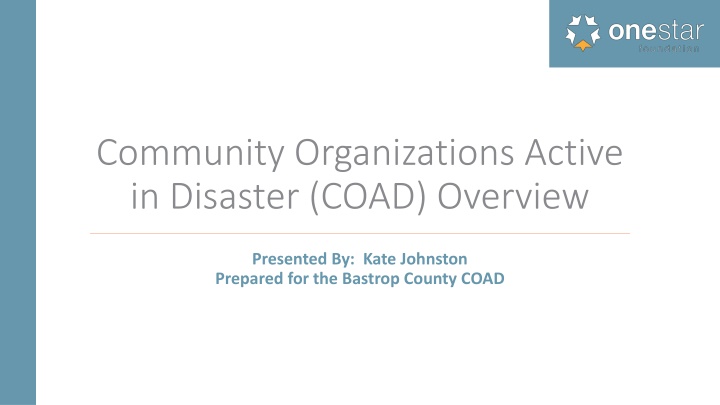
COAD Overview and Community Resilience Building Strategies
Explore the Community Organizations Active in Disaster (COAD) overview presented by Kate Johnston, focusing on building resilience by leveraging local assets. Learn how COAD aims to strengthen communities' capacity to prepare for, respond to, recover from, and mitigate disaster impacts through communication, coordination, cooperation, and collaboration.
Download Presentation

Please find below an Image/Link to download the presentation.
The content on the website is provided AS IS for your information and personal use only. It may not be sold, licensed, or shared on other websites without obtaining consent from the author. If you encounter any issues during the download, it is possible that the publisher has removed the file from their server.
You are allowed to download the files provided on this website for personal or commercial use, subject to the condition that they are used lawfully. All files are the property of their respective owners.
The content on the website is provided AS IS for your information and personal use only. It may not be sold, licensed, or shared on other websites without obtaining consent from the author.
E N D
Presentation Transcript
Community Organizations Active in Disaster (COAD) Overview Presented By: Kate Johnston Prepared for the Bastrop County COAD
Current Disaster Landscape Between May 2015 - October 2018, the State of Texas has received 8 Major Disaster Declarations. During this same timeframe, our nation has also been impacted by numerous catastrophic disasters. As a result, volunteer and donor fatigue have become our new normal. 2
Why COAD? To help mitigate against post-disaster resource constraints, communities are encouraged to take an asset-based approach to resilience that builds upon local resources. 3
Community Assets People Residents' skills, experiences, capacities, passions, and willingness can contribute to community strengthening. Stories carry the memory of a community and can describe the potential of a community based on previous times as remembered by those who live there. Associations in the community primarily run by volunteers, such as athletic clubs, faith-based groups, and others can contribute. Economy Economic assets include what residents produce and consume in the community, in both formal and informal ways. - Ex: local businesses, major employers, primary economic sectors (e.g., agriculture), and/or commercial centers. 4
Community Assets Built Environment Buildings, transportation, and facilities can contribute to community strengthening. - Ex: public spaces in the community such as schools, libraries, community centers. Natural Environment Environmental assets and natural resources are important to community identity and quality of life and support the economy through agriculture, tourism and recreation, and a variety of other ecosystem services, such as clean air and water. 5
COAD Mission To build and strengthen the capacity of local communities to prepare for, respond to, recover from, and mitigate against, the impact of disaster through the identification and engagement of community assets prior to an event. Communication develop channels for sharing information. Coordination efficiently utilize local resources without duplication of effort or benefit. Cooperation work together to overcome local challenges. Collaboration identify common goals and create shared solutions. 6
COAD/VOAD Community Organizations Active in Disaster (COAD) More localized focus, such as a community or County. Private sector partners and governmental agencies may hold membership, have voting privileges, and/or serve in leadership. Linked by purpose and function to a VOAD. Voluntary Organizations Active in Disaster (VOAD) Typically cover a larger jurisdiction, such as a region or State. Membership is typically restricted to voluntary organizations, as are voting privileges and the ability to hold office. 7
COAD Membership COAD membership is comprised of local organizations from the nonprofit, public, private, governmental, faith-based, and/or community-based sectors. All COAD members & partners are treated with parity, irrespective of sector or resources. 8
Examples of COAD Activities Volunteer Reception Center Donations Management Long-Term Recovery: Develop/Support LTRG Human Services Support Referrals Mitigation/Prevention: Public Education Hazard & Vulnerability Assessment Preparedness: Asset Mapping Resource Gap Analysis Community Disaster Planning Training and Exercises Response: Feeding Sheltering Short-Term Recovery: Multi-Agency Resource Center 9
Examples of COAD Resources Preparedness Chamber of Commerce Business continuity planning School District preparedness education OEM host training for COAD Response Volunteer Center - volunteer recruitment & coordination Social service agencies - support human services Restaurants & supermarkets - support feeding operations Short-Term Recovery Voluntary & faith-based organizations mucking & gutting Thrift Store & Goodwill management of unsolicited in-kind donations Long-Term Recovery Licensed contractors - repair, rebuild, construction management Social service agencies - disaster case management Small businesses in-kind & financial donations 10
Memorandums of Understanding (MOUs) MOU - nonbinding agreement between two or more parties outlining the terms and details of an understanding, including each parties' requirements and responsibilities. It is beneficial for a COAD to develop MOUs with local organizations that can can offer resources and/or services, as these agreements help to effectively and efficiently streamline the provision of resources without duplication of effort and/or benefit. MOUs should be developed prior to an event. Example: An MOU for pet boarding would outline the responsibilities between both the boarding facility and the COAD, including: type of animals, number of animals, food and water capacity, length of stay, quarantine areas, veterinarian availability, etc. 11
